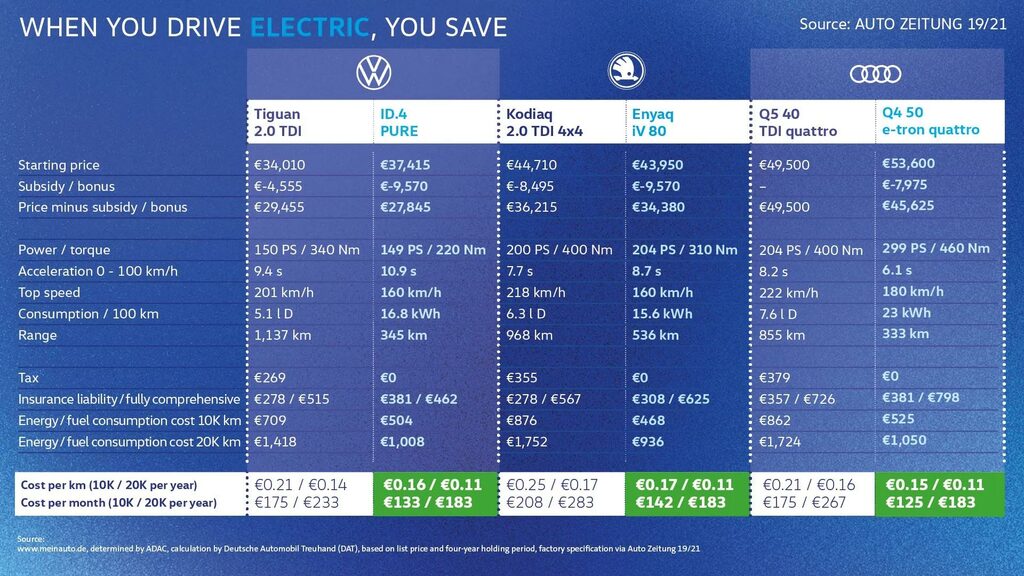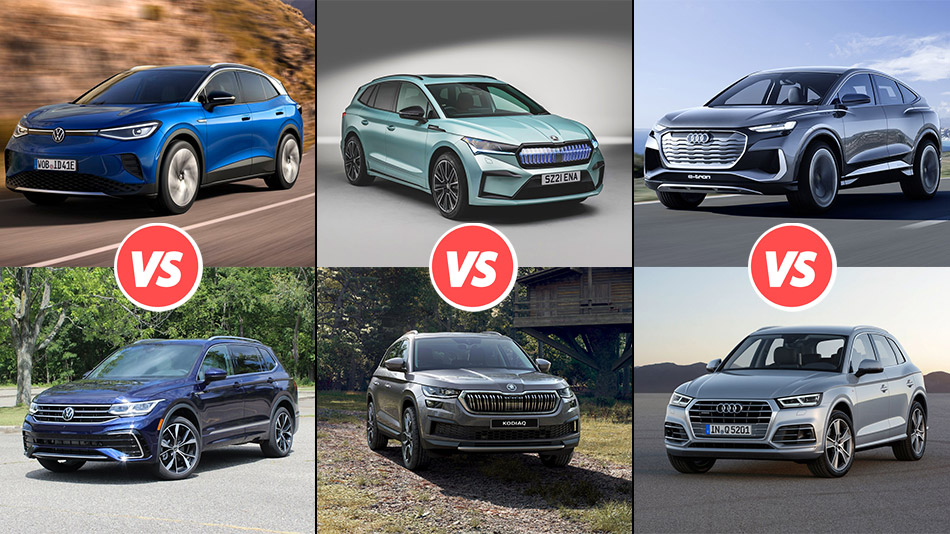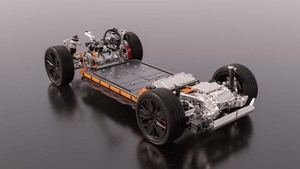Volkswagen, the world’s largest producer of fossil-powered vehicles (by revenue), has just presented a graphic comparing its diesel offerings to its electric ones. Comparing offerings from its VW, Skoda and Audi brands, it shows the equivalent electric models come out way ahead in terms of TCO savings and suggest it’s time to switch.
The data in VW’s graphic comes from Auto Zeitung, a German car magazine. The magazine did a series of tests of diesel and electric SUVs from various manufacturers. They selected the closest equivalents within each manufacturer and pitting them against each other in specs and total cost of ownership.
Then VW took this data and produced its own table, focusing on the vehicles produced by brands they own (VW, Skoda, and Audi. Auto Zeitung also tested a BMW and a Mercedes, with similar results. In all cases, the electric version not only starts at a lower price, but has significantly lower running costs. This lead to TCO as much as 50% higher for the diesel compared to the EV.
The graphic below has been shared by Herbert Dies – Chairman of the Board of Management of Volkswagen Group.

| Tiguan | ID4 | Kodiaq | Enyaq | Q5 40 | Q4 50 etron | |
|---|---|---|---|---|---|---|
| Cost per km (10k / 20k per year) | €0.21 / €0.14 | €0.16 / €0.11 | €0.25 / €0.17 | €0.17 / €0.11 | €0.21 / €0.16 | €0.15 / €0.11 |
| Cost per month (10k / 20k per year) | €175 / €233 | €133 / €183 | €208 / €283 | €142 / €183 | €175 / €267 | €125 / €183 |
Driving a combustion engine car costs up to 50% more compared to an e-car! The Autozeitung does the math, taking into account all the costs: Driving a VW Tiguan costs around 30% more per kilometer than an ID.4. One kilometer in an Audi Q5 costs around 40% more compared to a Q4 e-tron. And driving a Skoda Kodiaq is around 50% more expensive per kilometer compared to an Enyaq! It’s time to switch.
Herbert Diess
This data is from Germany, so it takes into account local purchase prices, German incentives (subsidy for EVs, dealer rebates for diesel versions), German energy costs (which are high, both for electric and diesel), insurance, tax, and so on. Auto Zeitung‘s also took into account depreciation and maintenance costs, though those were left out of the VW table. The final cost per km and cost per month are identical to Auto Zeitung‘s data, despite these omissions from the table.
Calculations will be different from place to place, but the general trend worldwide is that EVs are almost always cheaper to fuel and that end-user purchase prices are often comparable between similarly specced gas cars and their electric versions.
The key takeaway is that this table was publicised by VW CEO Herbert Diess, whose company produces as many cars as any company in the world (Toyota and VW have nearly identical unit sales). Over 96% of VW’s unit sales so far this year have been powered by fossil fuels. Despite that electric makes up such a small part of VW’s sales, Diess still chose to publicise that the vast majority of his company’s autos are overpriced compared to their closest electric competition.
It’s time to switch
This is not new for Fleet360. Fleet analysis and TCO calculations over the past years have shown the tipping point is actually now and came along sooner that expected. Diess is right when he says “it’s time to switch.” For many years, people have wondered when “price parity” would be achieved for electric vehicles, generally setting the date at some point in the future. But that date is already here. Auto Zeitung‘s numbers show that for similar vehicles, the EV is cheaper to own.
Are ICE and EV’s actually that similar?
The phrase ‘similar vehicles’ needs to be read wisely. In reality, are ICE and EVsa all that similar? Electric cars are much more pleasant to drive and own than their ICE counterparts, and the vast majority of electric car owners will tell you that the ownership experience is just so much better. Many drivers are not interested in going back once they have switched. And the calculus only gets better for EVs as each month passes and the world pivots more toward electrification.
So here we have vehicles with similar specs and options, but the EV has a lower starting price, lower ownership price, and a better experience. So what’s everyone waiting for? It’s time to switch.
What would you choose?

Selecting the best Powertrain to aid your switch
Based on TCO calculations, it is clear that subsidies, a lower energy consumption/cost and lower taxes are in favour of electric vehicles making them in most cases cheaper to drive. How much depends on the country and its related taxation/subsidy system. Fleet360 can help you prioritising countries for EV-implementation based on country specific TCO calculations.
Apart from cost, the mobility profile of the driver remains an important element in the assessment if a driver can use conveniently an electric vehicle. Fleet360 has developed a comprehensive Power Train Selector tool to automate and objectivise this process based on your specific EV including car policy.
Talk to us about your Fleet Electrification and make 2022 the year of the switch.



